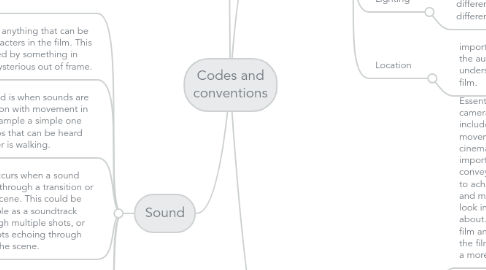Codes and conventions
von Jordan Perks


1. Aspects of a thriller
1.1. Changes in angle shots
1.2. Quick cuts
1.3. Low key lighting
1.4. Shadows
1.5. Black and white shots
2. Sound
2.1. Non-diegetic sound is the opposite to diegetic sound for it's audio only the audience can hear and the characters in the film are oblivious of it. This could be sound like a monologue or a soundtrack.
2.2. Diegetic sound is anything that can be heard by the characters in the film. This is usually produced by something in frame or some mysterious out of frame.
2.3. Synchronous sound is when sounds are made in conjunction with movement in the frame. For example a simple one would be footsteps that can be heard when the character is walking.
2.4. A sound bridge occurs when a sound carries on playing through a transition or cut to a different scene. This could be something as simple as a soundtrack overlapping through multiple shots, or maybe like gunshots echoing through different shots of the scene.
2.5. Pitch being the wavelength (frequency) of the sound wave. A high pitch sound would have compact high waves whereas a low pitch sound would have fewer waves and would be more distributed along the waveline. These pitches can be used to create different moods, and create suspense for example take Alfred Hitchcock's psycho stabbing scene which contains high pitch noises when the woman is being stabbed.
2.6. Ambient sound is used in the background of a scene and is not meant to be listened to as such, it's just there to make the environment sound more alive and create a mood in the scene.
3. Workflow
3.1. Makeup
3.1.1. Used alongside costumes to further enhance the feel to a character in a film and is also used to define facial features more prominently
3.2. Costumes
3.2.1. Important to give a character a backstory and feel in a film, costumes are used as a subtle way of representing the time of which the film takes place or what type of culture the characters in the film may have.
3.3. Lighting
3.3.1. Key, fill and high key lighting are three main points in lighting. They all give off different themes and are used for different scenarios.
3.4. Location
3.4.1. important for the film because it helps the audience establish theme and understand the simple premise of the film.
